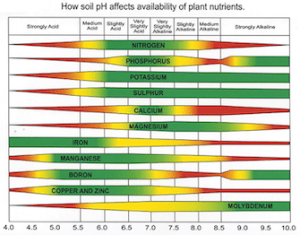Eco Farming Daily featured an article by Bill McKibben titled “Soil pH: Making Adjustments to Boost Fertility”. The title immediately peaked PJC interest because it’s so important to adjust pH to boost fertility when growing organic turf grass. In this article, McKibben covers: how a good soil test determines your direction, ideal pH range, and raising and lowering pH. Read the article in its entirety, and/or see what we have to say about it here at PJC!
Sean’s Take
This article from Bill McKibben highlights the importance of soil pH and optimizing it with an ‘inexpensive’ product—Lime. Whether you are building an ornamental garden, working in agriculture, or establishing a thick organic lawn—the first step is to determine the direction you need to influence soil conditions. Soil testing is that critical tool, and PJC Organic interprets soil test results to help guide the direction you need to go.
Bill McKibben notes that lime applications “need to be considered more like yearly fertilizer applications instead of a once every 3-5 year project”. I share the same sentiment. I feel strongly that calcium (Ca) should be considered tantamount to N-P-K on fertilizer labels due to its nutrient density. Additionally, calcium influences the availability of other nutrients in the soil profile.
McKibben states that “it is especially difficult to maintain enough soluble calcium in solution in light, sandy soils”. We see this all too often on soil tests in the North and South Shore of Boston. Sandy soils don’t have the ability to hold nutrients. Therefore, we typically see low cation presence. More importantly, these cations get depleted by the turf grass as it grows. Consequently, the soil pH drops, making it more difficult for turf grass to grow and requiring more work to get the soil chemistry back into balance. Therefore, regularly supplementing the soil with fertilizers and lime is the key to a successful program.
Availability of Plant Nutrients
PJC Organic helps you determine exactly how much lime you need annually to balance soil chemistry. This inexpensive product could be the make-or-break aspect of your organic turf care program.

This chart shows macronutrient and micronutrient availability at soil pH between 6.0 and 7.0 (6.5-6.8 is ideal for Turf Grass). You’ll notice the most critical micronutrient not available at a pH of 6.5 is iron – which is why we developed Boost+S3. PJC’s BOOST+S3 delivers supplemental iron needed for photosynthesis, humates for added cations, and gypsum for bioavailable calcium.
Fred’s Take
In the Northeast most of the soils you will encounter will be light, sandy soils. In addition, most soils will have organic matter levels less than 4% and a CEC below 10. As McKibben states, “it is especially difficult to maintain enough soluble calcium in solution in light, sandy soils”. If there is good news in this, it is that it takes less lime to affect a change in the pH, especially if one uses a high-efficiency lime that is ground finer.
It’s important that as organic matter levels increase over time, the buffering capacity of the soil will also increase, leading to more stable pH levels. PJC focuses on improving organic matter levels without synthetic fertilizers, increasing soil microbial activity, and implementing proper cultural practices (higher mower heights, clippings returned, etc…). We start with the soil and adjust pH to boost fertility and ensure sustainable turf growth. Learn more about PJC’s practical approach and proven products on our blog, or contact us for more information!
